Report: Compliance Management System Assessment for Charity-Care
VerifiedAdded on 2023/01/05
|14
|3062
|78
Report
AI Summary
This report presents a detailed assessment of a compliance management system (CMS) designed for Charity-Care, a not-for-profit charity. The report begins with an executive summary, followed by an introduction outlining the objectives of the CMS implementation plan. It defines the key components of a CMS, including board oversight, compliance programs, and compliance audits, with a focus on consumer complaint management. Personnel requirements are specified, detailing the roles and responsibilities of key individuals like the Board of Directors, CEO, business managers, and office staff. The report emphasizes the importance of training, outlining suitable training options for staff. Furthermore, it explores strategies for developing a strong compliance culture, including effective leadership and incentivizing ethical behavior. The report details processes and procedures for meeting compliance requirements and establishing internal and external liaison processes. Performance indicators and a comprehensive budget, including cost breakdowns for various elements such as personnel and system costs, are presented. Finally, the report concludes with a detailed action plan for the effective introduction and implementation of the CMS within Charity-Care.
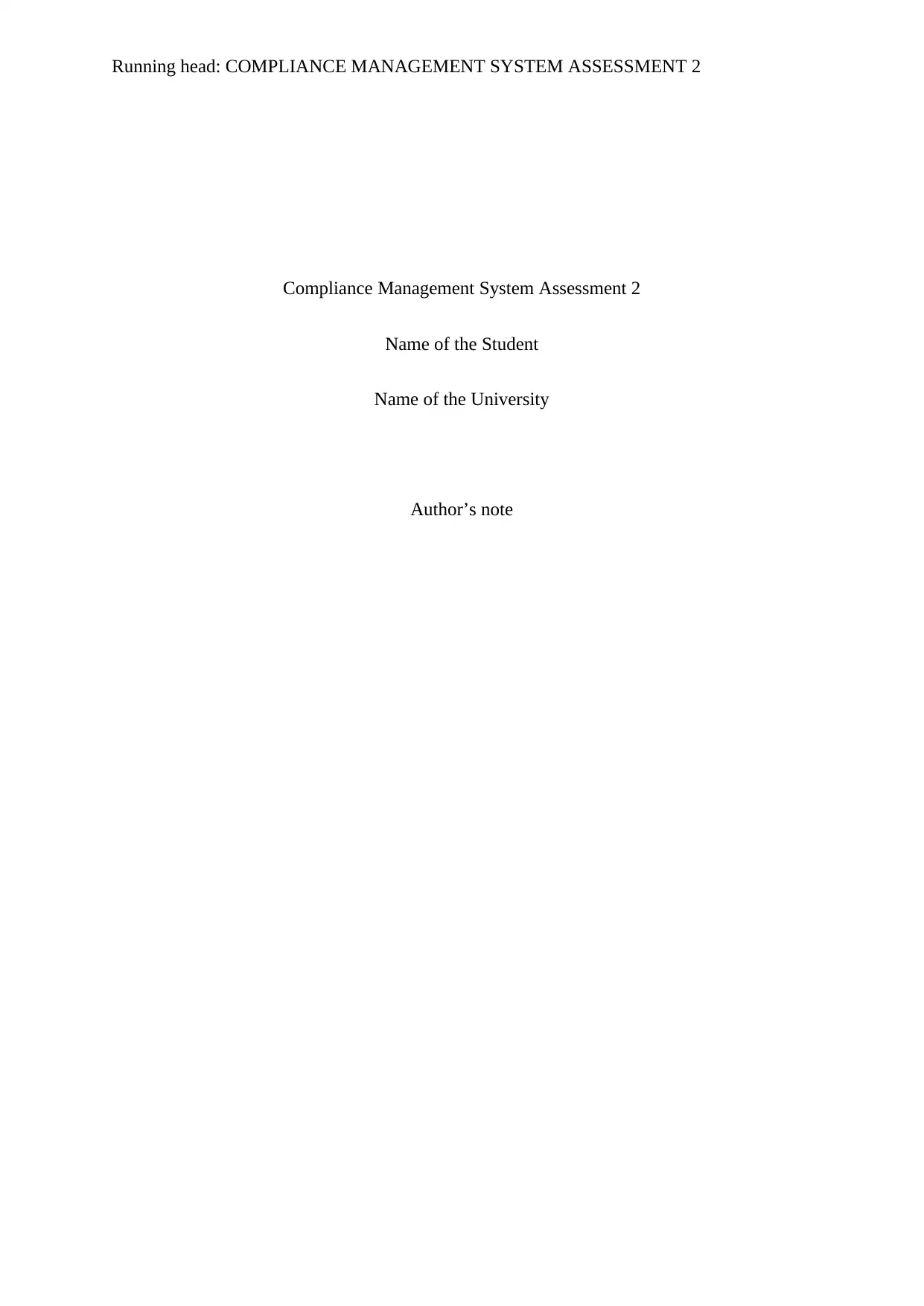
Running head: COMPLIANCE MANAGEMENT SYSTEM ASSESSMENT 2
Compliance Management System Assessment 2
Name of the Student
Name of the University
Author’s note
Compliance Management System Assessment 2
Name of the Student
Name of the University
Author’s note
Paraphrase This Document
Need a fresh take? Get an instant paraphrase of this document with our AI Paraphraser
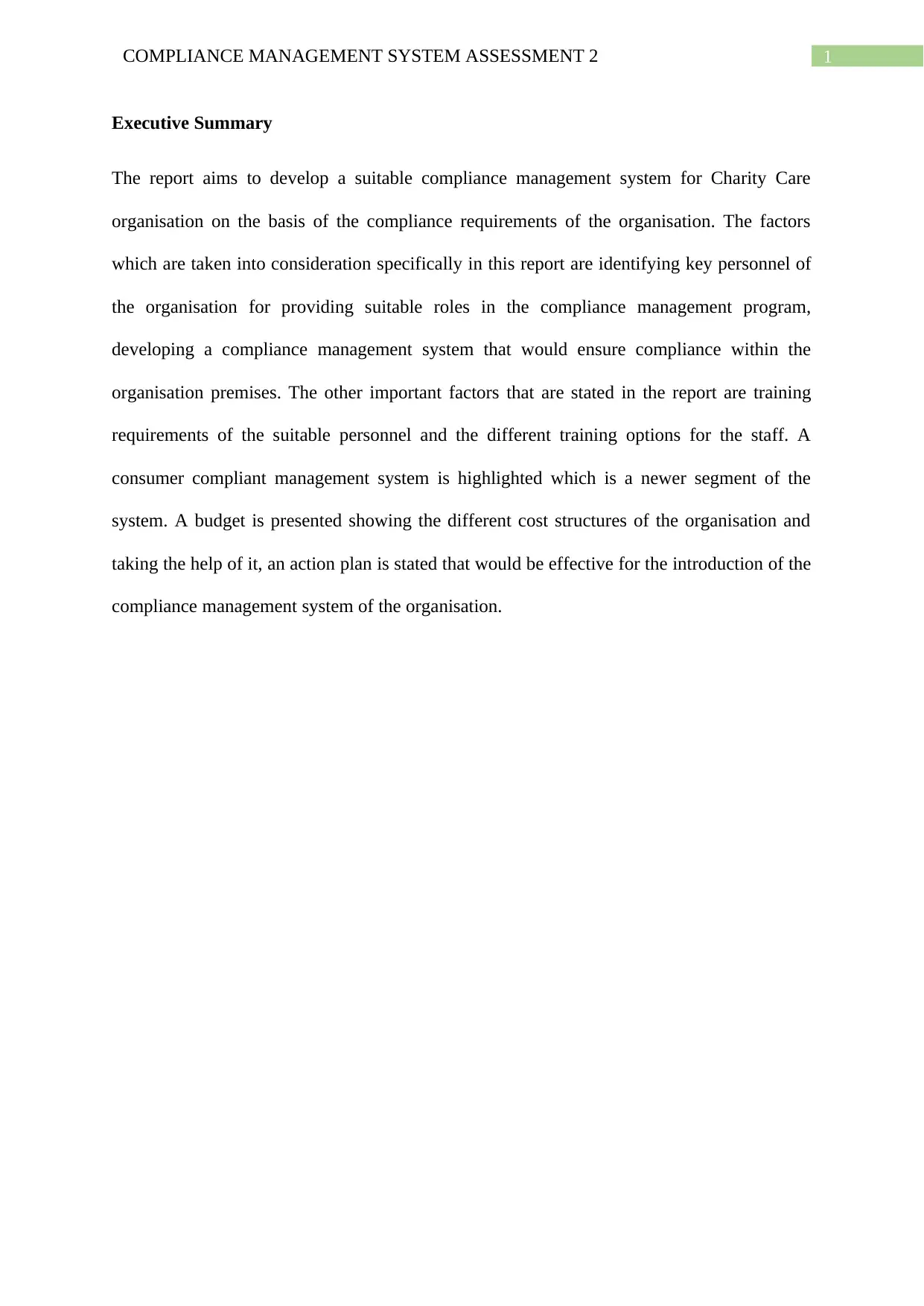
1COMPLIANCE MANAGEMENT SYSTEM ASSESSMENT 2
Executive Summary
The report aims to develop a suitable compliance management system for Charity Care
organisation on the basis of the compliance requirements of the organisation. The factors
which are taken into consideration specifically in this report are identifying key personnel of
the organisation for providing suitable roles in the compliance management program,
developing a compliance management system that would ensure compliance within the
organisation premises. The other important factors that are stated in the report are training
requirements of the suitable personnel and the different training options for the staff. A
consumer compliant management system is highlighted which is a newer segment of the
system. A budget is presented showing the different cost structures of the organisation and
taking the help of it, an action plan is stated that would be effective for the introduction of the
compliance management system of the organisation.
Executive Summary
The report aims to develop a suitable compliance management system for Charity Care
organisation on the basis of the compliance requirements of the organisation. The factors
which are taken into consideration specifically in this report are identifying key personnel of
the organisation for providing suitable roles in the compliance management program,
developing a compliance management system that would ensure compliance within the
organisation premises. The other important factors that are stated in the report are training
requirements of the suitable personnel and the different training options for the staff. A
consumer compliant management system is highlighted which is a newer segment of the
system. A budget is presented showing the different cost structures of the organisation and
taking the help of it, an action plan is stated that would be effective for the introduction of the
compliance management system of the organisation.
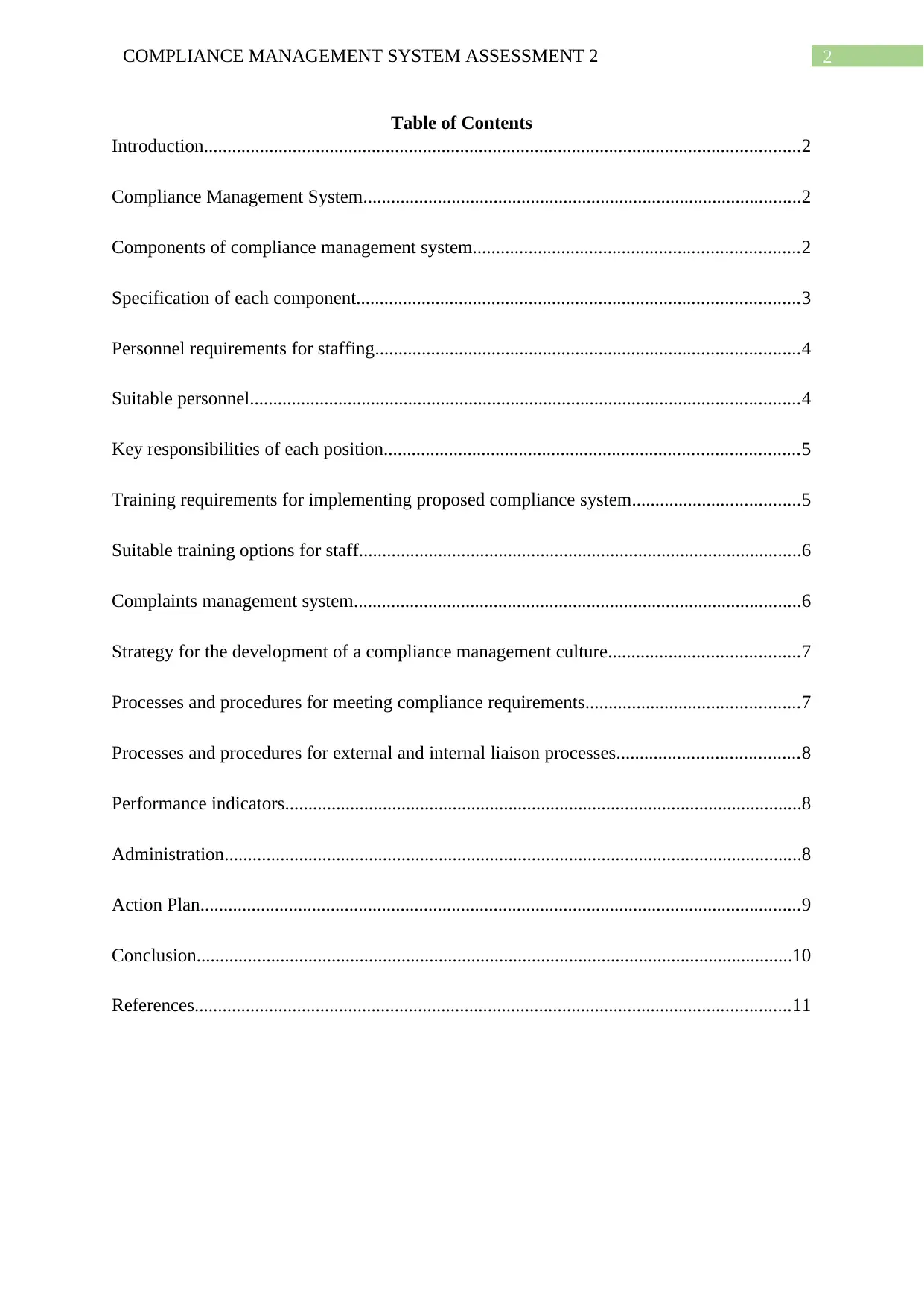
2COMPLIANCE MANAGEMENT SYSTEM ASSESSMENT 2
Table of Contents
Introduction................................................................................................................................2
Compliance Management System..............................................................................................2
Components of compliance management system......................................................................2
Specification of each component...............................................................................................3
Personnel requirements for staffing...........................................................................................4
Suitable personnel......................................................................................................................4
Key responsibilities of each position.........................................................................................5
Training requirements for implementing proposed compliance system....................................5
Suitable training options for staff...............................................................................................6
Complaints management system................................................................................................6
Strategy for the development of a compliance management culture.........................................7
Processes and procedures for meeting compliance requirements..............................................7
Processes and procedures for external and internal liaison processes.......................................8
Performance indicators...............................................................................................................8
Administration............................................................................................................................8
Action Plan.................................................................................................................................9
Conclusion................................................................................................................................10
References................................................................................................................................11
Table of Contents
Introduction................................................................................................................................2
Compliance Management System..............................................................................................2
Components of compliance management system......................................................................2
Specification of each component...............................................................................................3
Personnel requirements for staffing...........................................................................................4
Suitable personnel......................................................................................................................4
Key responsibilities of each position.........................................................................................5
Training requirements for implementing proposed compliance system....................................5
Suitable training options for staff...............................................................................................6
Complaints management system................................................................................................6
Strategy for the development of a compliance management culture.........................................7
Processes and procedures for meeting compliance requirements..............................................7
Processes and procedures for external and internal liaison processes.......................................8
Performance indicators...............................................................................................................8
Administration............................................................................................................................8
Action Plan.................................................................................................................................9
Conclusion................................................................................................................................10
References................................................................................................................................11
⊘ This is a preview!⊘
Do you want full access?
Subscribe today to unlock all pages.

Trusted by 1+ million students worldwide
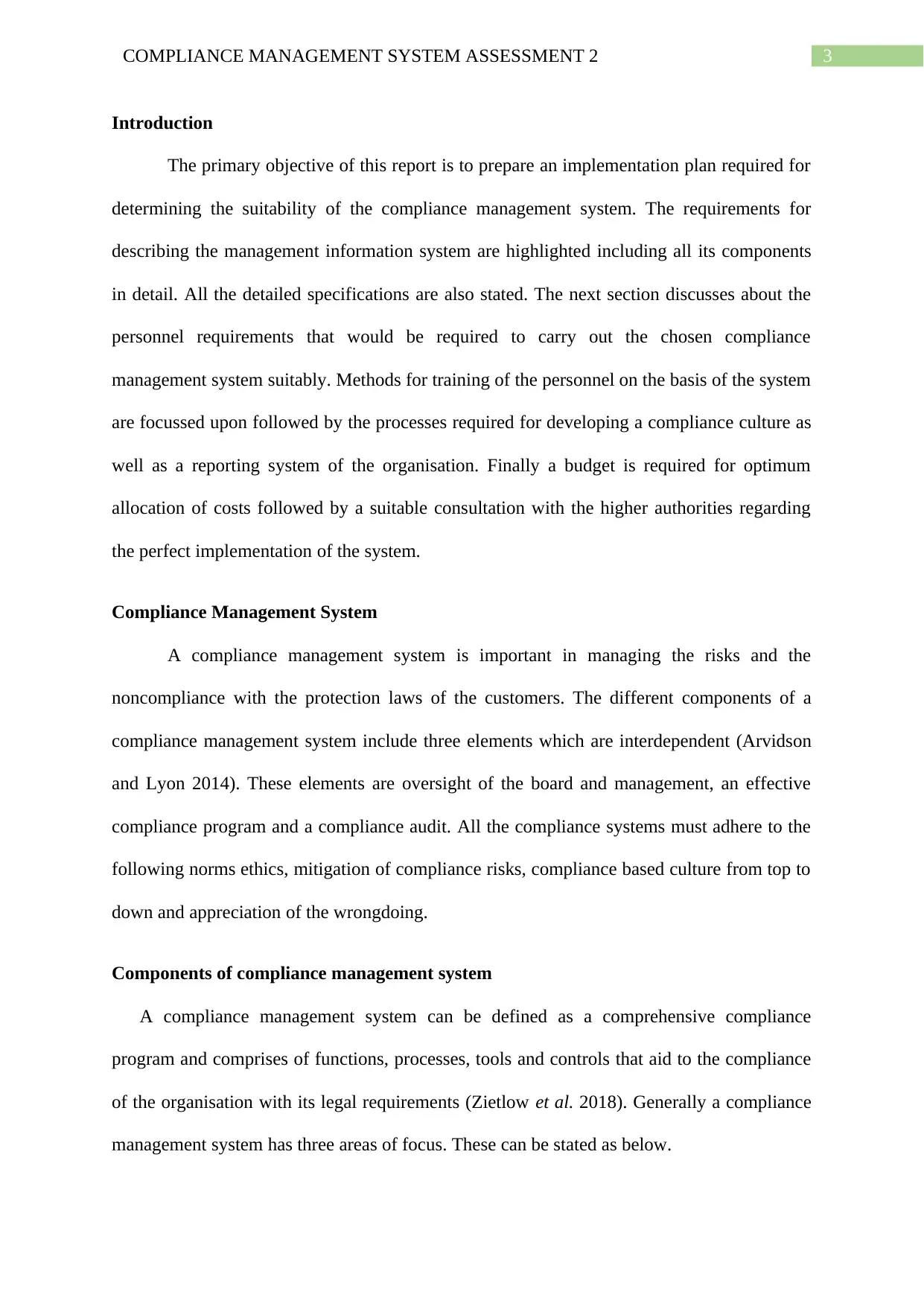
3COMPLIANCE MANAGEMENT SYSTEM ASSESSMENT 2
Introduction
The primary objective of this report is to prepare an implementation plan required for
determining the suitability of the compliance management system. The requirements for
describing the management information system are highlighted including all its components
in detail. All the detailed specifications are also stated. The next section discusses about the
personnel requirements that would be required to carry out the chosen compliance
management system suitably. Methods for training of the personnel on the basis of the system
are focussed upon followed by the processes required for developing a compliance culture as
well as a reporting system of the organisation. Finally a budget is required for optimum
allocation of costs followed by a suitable consultation with the higher authorities regarding
the perfect implementation of the system.
Compliance Management System
A compliance management system is important in managing the risks and the
noncompliance with the protection laws of the customers. The different components of a
compliance management system include three elements which are interdependent (Arvidson
and Lyon 2014). These elements are oversight of the board and management, an effective
compliance program and a compliance audit. All the compliance systems must adhere to the
following norms ethics, mitigation of compliance risks, compliance based culture from top to
down and appreciation of the wrongdoing.
Components of compliance management system
A compliance management system can be defined as a comprehensive compliance
program and comprises of functions, processes, tools and controls that aid to the compliance
of the organisation with its legal requirements (Zietlow et al. 2018). Generally a compliance
management system has three areas of focus. These can be stated as below.
Introduction
The primary objective of this report is to prepare an implementation plan required for
determining the suitability of the compliance management system. The requirements for
describing the management information system are highlighted including all its components
in detail. All the detailed specifications are also stated. The next section discusses about the
personnel requirements that would be required to carry out the chosen compliance
management system suitably. Methods for training of the personnel on the basis of the system
are focussed upon followed by the processes required for developing a compliance culture as
well as a reporting system of the organisation. Finally a budget is required for optimum
allocation of costs followed by a suitable consultation with the higher authorities regarding
the perfect implementation of the system.
Compliance Management System
A compliance management system is important in managing the risks and the
noncompliance with the protection laws of the customers. The different components of a
compliance management system include three elements which are interdependent (Arvidson
and Lyon 2014). These elements are oversight of the board and management, an effective
compliance program and a compliance audit. All the compliance systems must adhere to the
following norms ethics, mitigation of compliance risks, compliance based culture from top to
down and appreciation of the wrongdoing.
Components of compliance management system
A compliance management system can be defined as a comprehensive compliance
program and comprises of functions, processes, tools and controls that aid to the compliance
of the organisation with its legal requirements (Zietlow et al. 2018). Generally a compliance
management system has three areas of focus. These can be stated as below.
Paraphrase This Document
Need a fresh take? Get an instant paraphrase of this document with our AI Paraphraser
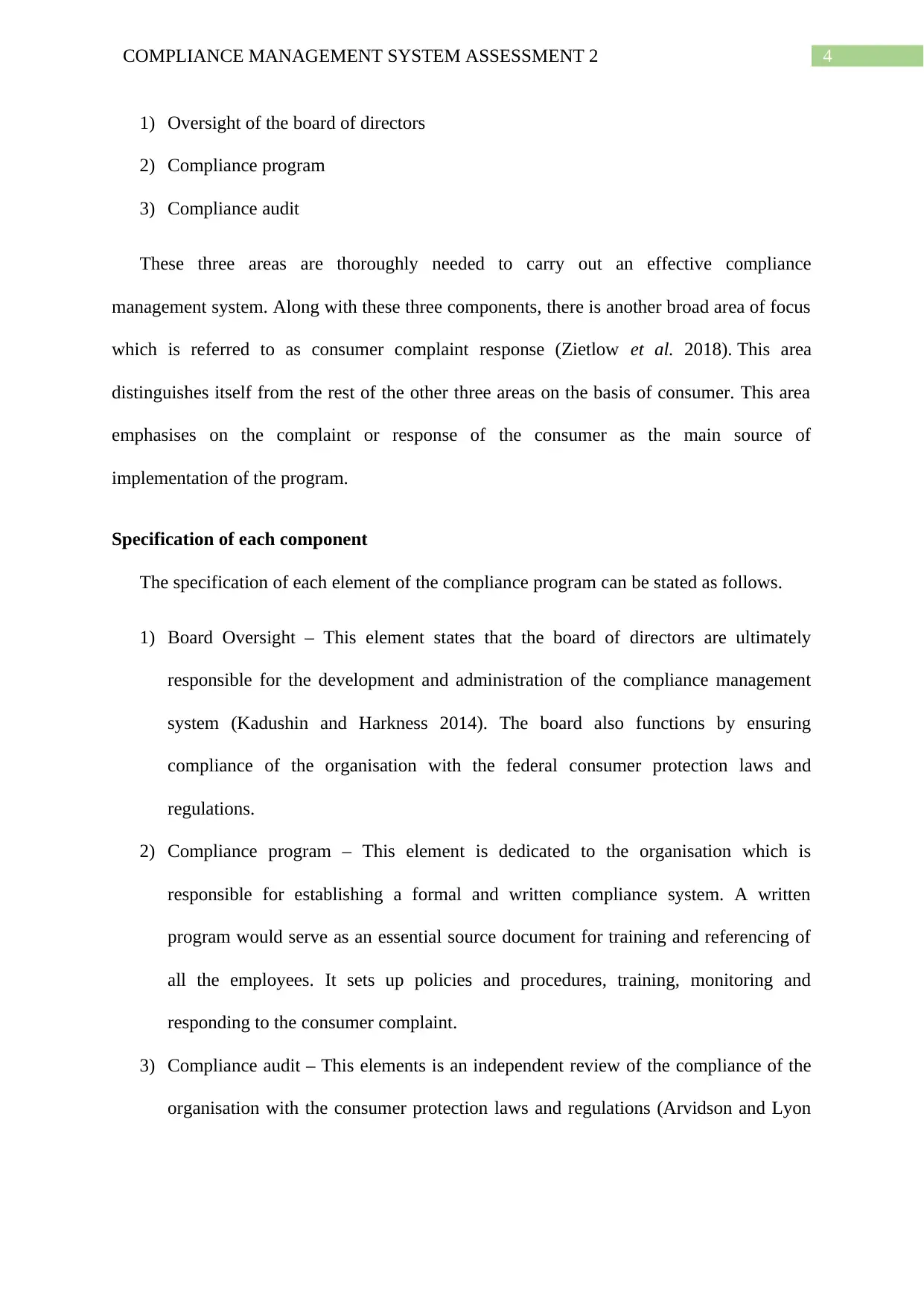
4COMPLIANCE MANAGEMENT SYSTEM ASSESSMENT 2
1) Oversight of the board of directors
2) Compliance program
3) Compliance audit
These three areas are thoroughly needed to carry out an effective compliance
management system. Along with these three components, there is another broad area of focus
which is referred to as consumer complaint response (Zietlow et al. 2018). This area
distinguishes itself from the rest of the other three areas on the basis of consumer. This area
emphasises on the complaint or response of the consumer as the main source of
implementation of the program.
Specification of each component
The specification of each element of the compliance program can be stated as follows.
1) Board Oversight – This element states that the board of directors are ultimately
responsible for the development and administration of the compliance management
system (Kadushin and Harkness 2014). The board also functions by ensuring
compliance of the organisation with the federal consumer protection laws and
regulations.
2) Compliance program – This element is dedicated to the organisation which is
responsible for establishing a formal and written compliance system. A written
program would serve as an essential source document for training and referencing of
all the employees. It sets up policies and procedures, training, monitoring and
responding to the consumer complaint.
3) Compliance audit – This elements is an independent review of the compliance of the
organisation with the consumer protection laws and regulations (Arvidson and Lyon
1) Oversight of the board of directors
2) Compliance program
3) Compliance audit
These three areas are thoroughly needed to carry out an effective compliance
management system. Along with these three components, there is another broad area of focus
which is referred to as consumer complaint response (Zietlow et al. 2018). This area
distinguishes itself from the rest of the other three areas on the basis of consumer. This area
emphasises on the complaint or response of the consumer as the main source of
implementation of the program.
Specification of each component
The specification of each element of the compliance program can be stated as follows.
1) Board Oversight – This element states that the board of directors are ultimately
responsible for the development and administration of the compliance management
system (Kadushin and Harkness 2014). The board also functions by ensuring
compliance of the organisation with the federal consumer protection laws and
regulations.
2) Compliance program – This element is dedicated to the organisation which is
responsible for establishing a formal and written compliance system. A written
program would serve as an essential source document for training and referencing of
all the employees. It sets up policies and procedures, training, monitoring and
responding to the consumer complaint.
3) Compliance audit – This elements is an independent review of the compliance of the
organisation with the consumer protection laws and regulations (Arvidson and Lyon
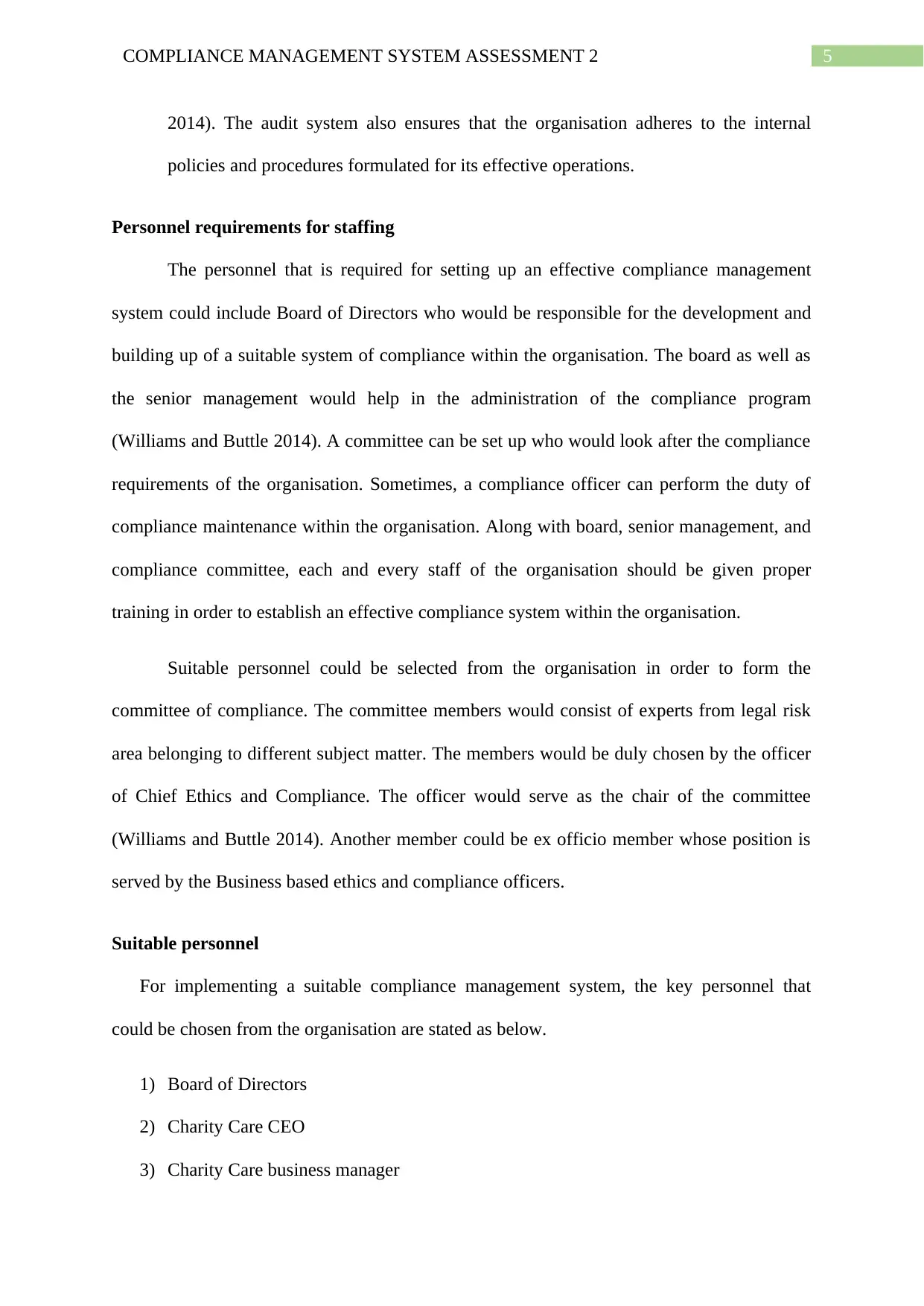
5COMPLIANCE MANAGEMENT SYSTEM ASSESSMENT 2
2014). The audit system also ensures that the organisation adheres to the internal
policies and procedures formulated for its effective operations.
Personnel requirements for staffing
The personnel that is required for setting up an effective compliance management
system could include Board of Directors who would be responsible for the development and
building up of a suitable system of compliance within the organisation. The board as well as
the senior management would help in the administration of the compliance program
(Williams and Buttle 2014). A committee can be set up who would look after the compliance
requirements of the organisation. Sometimes, a compliance officer can perform the duty of
compliance maintenance within the organisation. Along with board, senior management, and
compliance committee, each and every staff of the organisation should be given proper
training in order to establish an effective compliance system within the organisation.
Suitable personnel could be selected from the organisation in order to form the
committee of compliance. The committee members would consist of experts from legal risk
area belonging to different subject matter. The members would be duly chosen by the officer
of Chief Ethics and Compliance. The officer would serve as the chair of the committee
(Williams and Buttle 2014). Another member could be ex officio member whose position is
served by the Business based ethics and compliance officers.
Suitable personnel
For implementing a suitable compliance management system, the key personnel that
could be chosen from the organisation are stated as below.
1) Board of Directors
2) Charity Care CEO
3) Charity Care business manager
2014). The audit system also ensures that the organisation adheres to the internal
policies and procedures formulated for its effective operations.
Personnel requirements for staffing
The personnel that is required for setting up an effective compliance management
system could include Board of Directors who would be responsible for the development and
building up of a suitable system of compliance within the organisation. The board as well as
the senior management would help in the administration of the compliance program
(Williams and Buttle 2014). A committee can be set up who would look after the compliance
requirements of the organisation. Sometimes, a compliance officer can perform the duty of
compliance maintenance within the organisation. Along with board, senior management, and
compliance committee, each and every staff of the organisation should be given proper
training in order to establish an effective compliance system within the organisation.
Suitable personnel could be selected from the organisation in order to form the
committee of compliance. The committee members would consist of experts from legal risk
area belonging to different subject matter. The members would be duly chosen by the officer
of Chief Ethics and Compliance. The officer would serve as the chair of the committee
(Williams and Buttle 2014). Another member could be ex officio member whose position is
served by the Business based ethics and compliance officers.
Suitable personnel
For implementing a suitable compliance management system, the key personnel that
could be chosen from the organisation are stated as below.
1) Board of Directors
2) Charity Care CEO
3) Charity Care business manager
⊘ This is a preview!⊘
Do you want full access?
Subscribe today to unlock all pages.

Trusted by 1+ million students worldwide
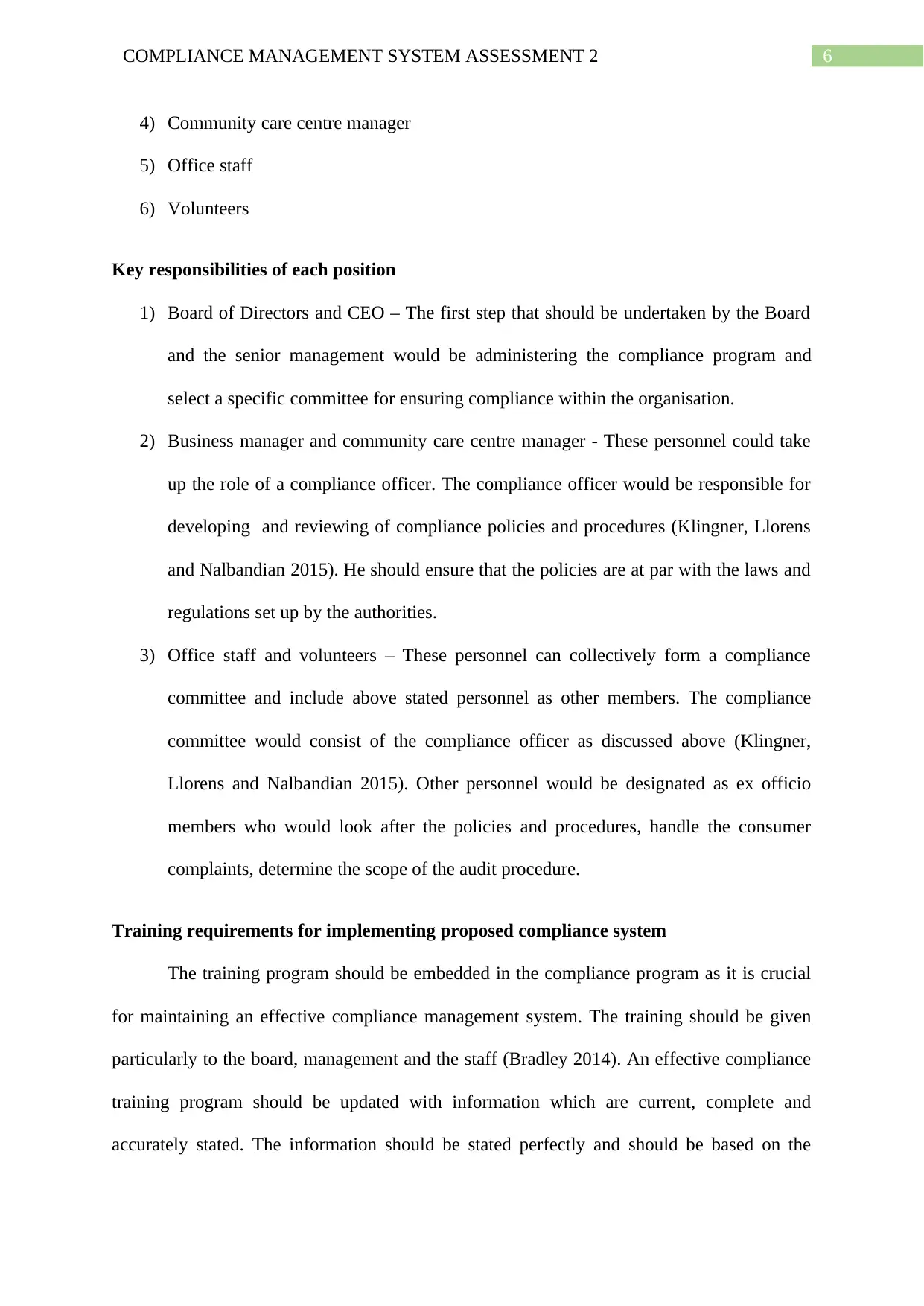
6COMPLIANCE MANAGEMENT SYSTEM ASSESSMENT 2
4) Community care centre manager
5) Office staff
6) Volunteers
Key responsibilities of each position
1) Board of Directors and CEO – The first step that should be undertaken by the Board
and the senior management would be administering the compliance program and
select a specific committee for ensuring compliance within the organisation.
2) Business manager and community care centre manager - These personnel could take
up the role of a compliance officer. The compliance officer would be responsible for
developing and reviewing of compliance policies and procedures (Klingner, Llorens
and Nalbandian 2015). He should ensure that the policies are at par with the laws and
regulations set up by the authorities.
3) Office staff and volunteers – These personnel can collectively form a compliance
committee and include above stated personnel as other members. The compliance
committee would consist of the compliance officer as discussed above (Klingner,
Llorens and Nalbandian 2015). Other personnel would be designated as ex officio
members who would look after the policies and procedures, handle the consumer
complaints, determine the scope of the audit procedure.
Training requirements for implementing proposed compliance system
The training program should be embedded in the compliance program as it is crucial
for maintaining an effective compliance management system. The training should be given
particularly to the board, management and the staff (Bradley 2014). An effective compliance
training program should be updated with information which are current, complete and
accurately stated. The information should be stated perfectly and should be based on the
4) Community care centre manager
5) Office staff
6) Volunteers
Key responsibilities of each position
1) Board of Directors and CEO – The first step that should be undertaken by the Board
and the senior management would be administering the compliance program and
select a specific committee for ensuring compliance within the organisation.
2) Business manager and community care centre manager - These personnel could take
up the role of a compliance officer. The compliance officer would be responsible for
developing and reviewing of compliance policies and procedures (Klingner, Llorens
and Nalbandian 2015). He should ensure that the policies are at par with the laws and
regulations set up by the authorities.
3) Office staff and volunteers – These personnel can collectively form a compliance
committee and include above stated personnel as other members. The compliance
committee would consist of the compliance officer as discussed above (Klingner,
Llorens and Nalbandian 2015). Other personnel would be designated as ex officio
members who would look after the policies and procedures, handle the consumer
complaints, determine the scope of the audit procedure.
Training requirements for implementing proposed compliance system
The training program should be embedded in the compliance program as it is crucial
for maintaining an effective compliance management system. The training should be given
particularly to the board, management and the staff (Bradley 2014). An effective compliance
training program should be updated with information which are current, complete and
accurately stated. The information should be stated perfectly and should be based on the
Paraphrase This Document
Need a fresh take? Get an instant paraphrase of this document with our AI Paraphraser
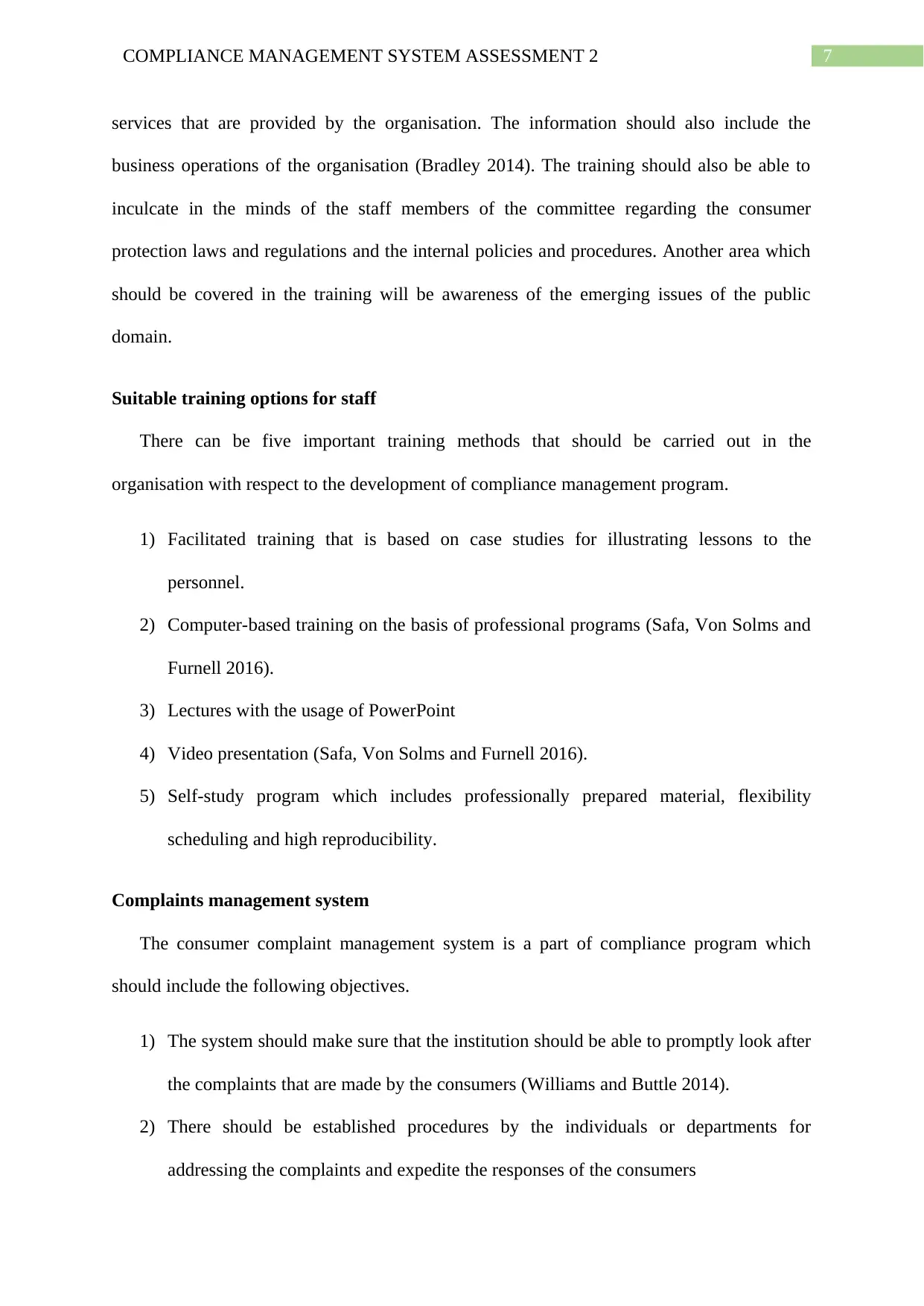
7COMPLIANCE MANAGEMENT SYSTEM ASSESSMENT 2
services that are provided by the organisation. The information should also include the
business operations of the organisation (Bradley 2014). The training should also be able to
inculcate in the minds of the staff members of the committee regarding the consumer
protection laws and regulations and the internal policies and procedures. Another area which
should be covered in the training will be awareness of the emerging issues of the public
domain.
Suitable training options for staff
There can be five important training methods that should be carried out in the
organisation with respect to the development of compliance management program.
1) Facilitated training that is based on case studies for illustrating lessons to the
personnel.
2) Computer-based training on the basis of professional programs (Safa, Von Solms and
Furnell 2016).
3) Lectures with the usage of PowerPoint
4) Video presentation (Safa, Von Solms and Furnell 2016).
5) Self-study program which includes professionally prepared material, flexibility
scheduling and high reproducibility.
Complaints management system
The consumer complaint management system is a part of compliance program which
should include the following objectives.
1) The system should make sure that the institution should be able to promptly look after
the complaints that are made by the consumers (Williams and Buttle 2014).
2) There should be established procedures by the individuals or departments for
addressing the complaints and expedite the responses of the consumers
services that are provided by the organisation. The information should also include the
business operations of the organisation (Bradley 2014). The training should also be able to
inculcate in the minds of the staff members of the committee regarding the consumer
protection laws and regulations and the internal policies and procedures. Another area which
should be covered in the training will be awareness of the emerging issues of the public
domain.
Suitable training options for staff
There can be five important training methods that should be carried out in the
organisation with respect to the development of compliance management program.
1) Facilitated training that is based on case studies for illustrating lessons to the
personnel.
2) Computer-based training on the basis of professional programs (Safa, Von Solms and
Furnell 2016).
3) Lectures with the usage of PowerPoint
4) Video presentation (Safa, Von Solms and Furnell 2016).
5) Self-study program which includes professionally prepared material, flexibility
scheduling and high reproducibility.
Complaints management system
The consumer complaint management system is a part of compliance program which
should include the following objectives.
1) The system should make sure that the institution should be able to promptly look after
the complaints that are made by the consumers (Williams and Buttle 2014).
2) There should be established procedures by the individuals or departments for
addressing the complaints and expedite the responses of the consumers
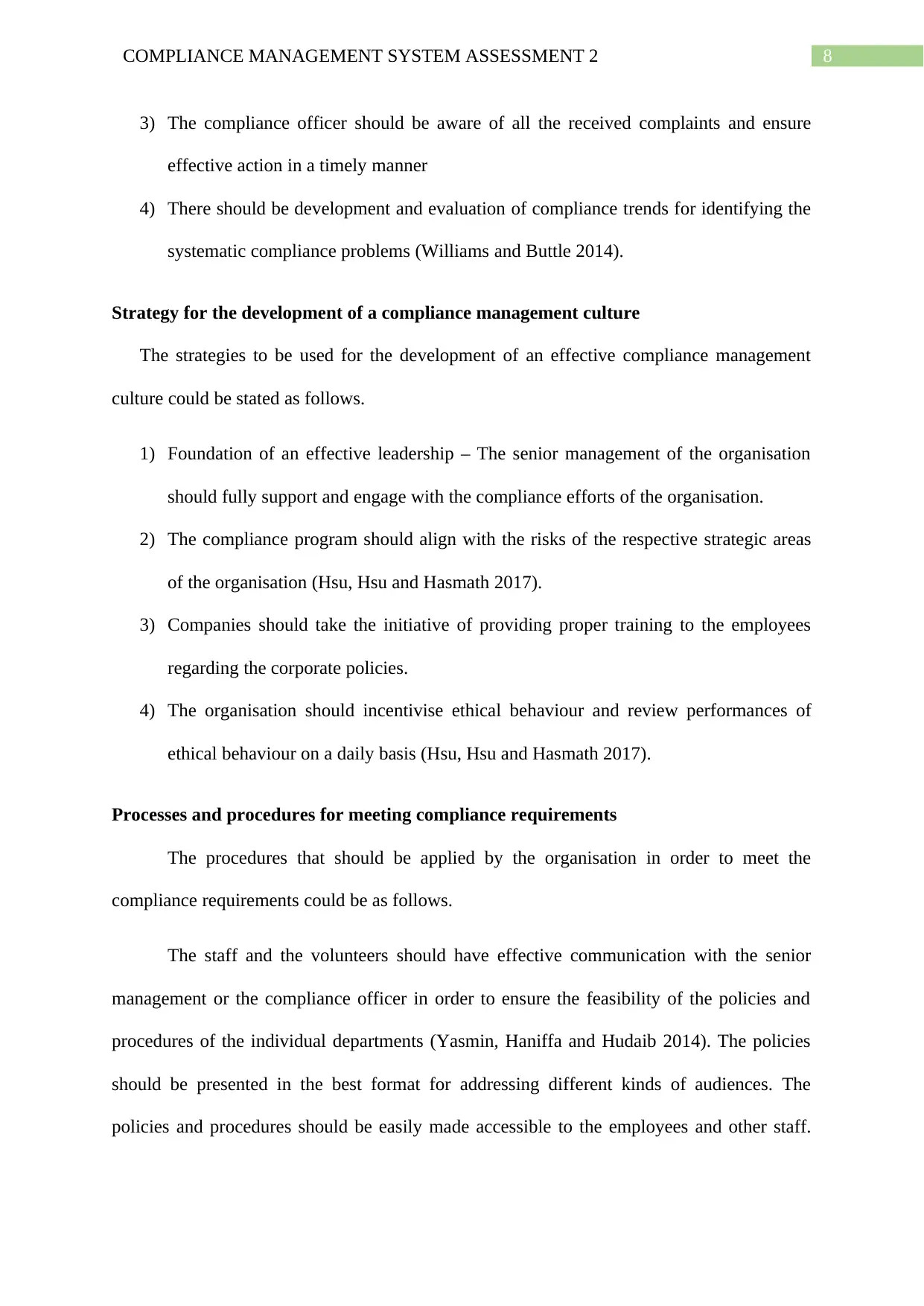
8COMPLIANCE MANAGEMENT SYSTEM ASSESSMENT 2
3) The compliance officer should be aware of all the received complaints and ensure
effective action in a timely manner
4) There should be development and evaluation of compliance trends for identifying the
systematic compliance problems (Williams and Buttle 2014).
Strategy for the development of a compliance management culture
The strategies to be used for the development of an effective compliance management
culture could be stated as follows.
1) Foundation of an effective leadership – The senior management of the organisation
should fully support and engage with the compliance efforts of the organisation.
2) The compliance program should align with the risks of the respective strategic areas
of the organisation (Hsu, Hsu and Hasmath 2017).
3) Companies should take the initiative of providing proper training to the employees
regarding the corporate policies.
4) The organisation should incentivise ethical behaviour and review performances of
ethical behaviour on a daily basis (Hsu, Hsu and Hasmath 2017).
Processes and procedures for meeting compliance requirements
The procedures that should be applied by the organisation in order to meet the
compliance requirements could be as follows.
The staff and the volunteers should have effective communication with the senior
management or the compliance officer in order to ensure the feasibility of the policies and
procedures of the individual departments (Yasmin, Haniffa and Hudaib 2014). The policies
should be presented in the best format for addressing different kinds of audiences. The
policies and procedures should be easily made accessible to the employees and other staff.
3) The compliance officer should be aware of all the received complaints and ensure
effective action in a timely manner
4) There should be development and evaluation of compliance trends for identifying the
systematic compliance problems (Williams and Buttle 2014).
Strategy for the development of a compliance management culture
The strategies to be used for the development of an effective compliance management
culture could be stated as follows.
1) Foundation of an effective leadership – The senior management of the organisation
should fully support and engage with the compliance efforts of the organisation.
2) The compliance program should align with the risks of the respective strategic areas
of the organisation (Hsu, Hsu and Hasmath 2017).
3) Companies should take the initiative of providing proper training to the employees
regarding the corporate policies.
4) The organisation should incentivise ethical behaviour and review performances of
ethical behaviour on a daily basis (Hsu, Hsu and Hasmath 2017).
Processes and procedures for meeting compliance requirements
The procedures that should be applied by the organisation in order to meet the
compliance requirements could be as follows.
The staff and the volunteers should have effective communication with the senior
management or the compliance officer in order to ensure the feasibility of the policies and
procedures of the individual departments (Yasmin, Haniffa and Hudaib 2014). The policies
should be presented in the best format for addressing different kinds of audiences. The
policies and procedures should be easily made accessible to the employees and other staff.
⊘ This is a preview!⊘
Do you want full access?
Subscribe today to unlock all pages.

Trusted by 1+ million students worldwide
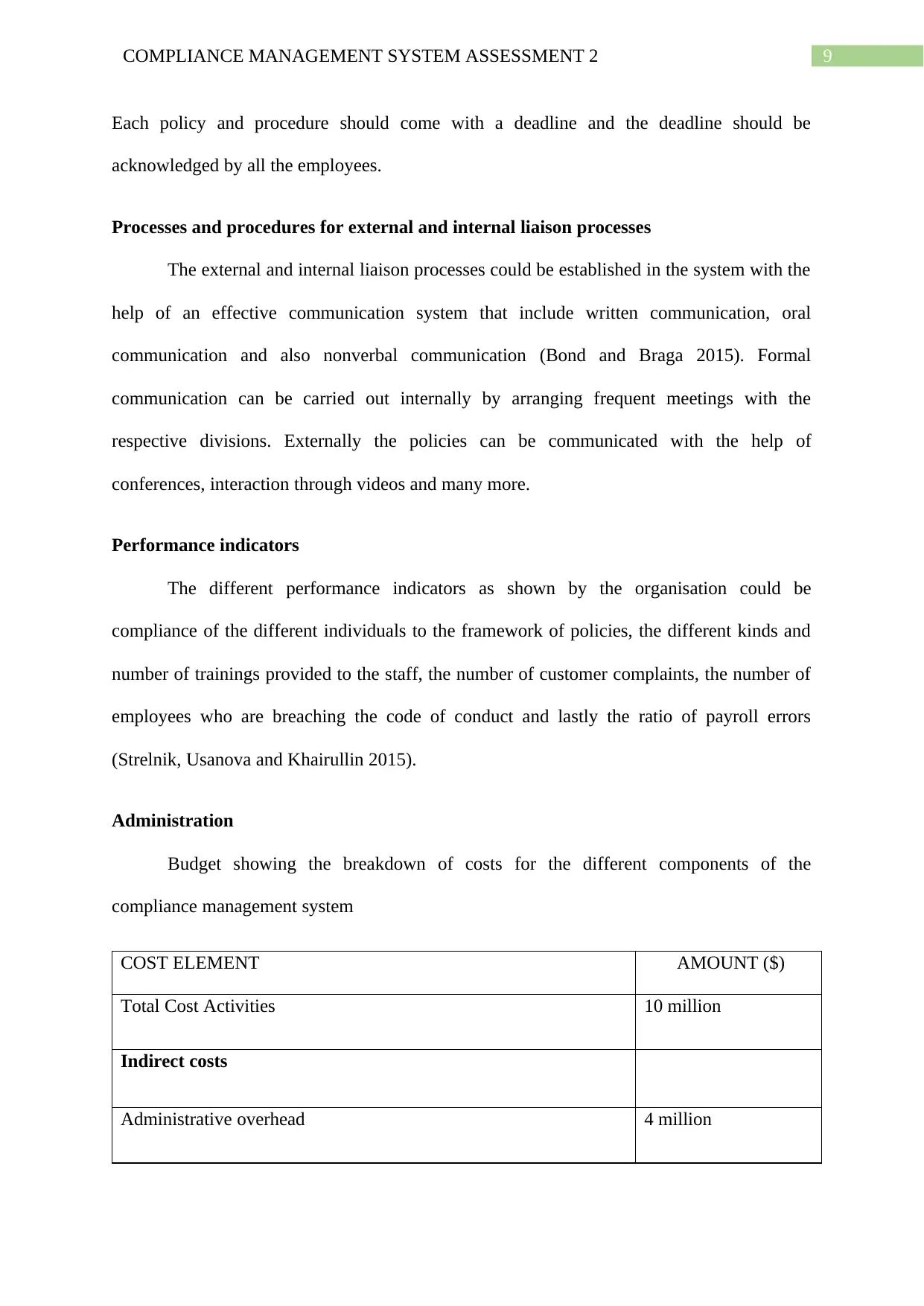
9COMPLIANCE MANAGEMENT SYSTEM ASSESSMENT 2
Each policy and procedure should come with a deadline and the deadline should be
acknowledged by all the employees.
Processes and procedures for external and internal liaison processes
The external and internal liaison processes could be established in the system with the
help of an effective communication system that include written communication, oral
communication and also nonverbal communication (Bond and Braga 2015). Formal
communication can be carried out internally by arranging frequent meetings with the
respective divisions. Externally the policies can be communicated with the help of
conferences, interaction through videos and many more.
Performance indicators
The different performance indicators as shown by the organisation could be
compliance of the different individuals to the framework of policies, the different kinds and
number of trainings provided to the staff, the number of customer complaints, the number of
employees who are breaching the code of conduct and lastly the ratio of payroll errors
(Strelnik, Usanova and Khairullin 2015).
Administration
Budget showing the breakdown of costs for the different components of the
compliance management system
COST ELEMENT AMOUNT ($)
Total Cost Activities 10 million
Indirect costs
Administrative overhead 4 million
Each policy and procedure should come with a deadline and the deadline should be
acknowledged by all the employees.
Processes and procedures for external and internal liaison processes
The external and internal liaison processes could be established in the system with the
help of an effective communication system that include written communication, oral
communication and also nonverbal communication (Bond and Braga 2015). Formal
communication can be carried out internally by arranging frequent meetings with the
respective divisions. Externally the policies can be communicated with the help of
conferences, interaction through videos and many more.
Performance indicators
The different performance indicators as shown by the organisation could be
compliance of the different individuals to the framework of policies, the different kinds and
number of trainings provided to the staff, the number of customer complaints, the number of
employees who are breaching the code of conduct and lastly the ratio of payroll errors
(Strelnik, Usanova and Khairullin 2015).
Administration
Budget showing the breakdown of costs for the different components of the
compliance management system
COST ELEMENT AMOUNT ($)
Total Cost Activities 10 million
Indirect costs
Administrative overhead 4 million
Paraphrase This Document
Need a fresh take? Get an instant paraphrase of this document with our AI Paraphraser
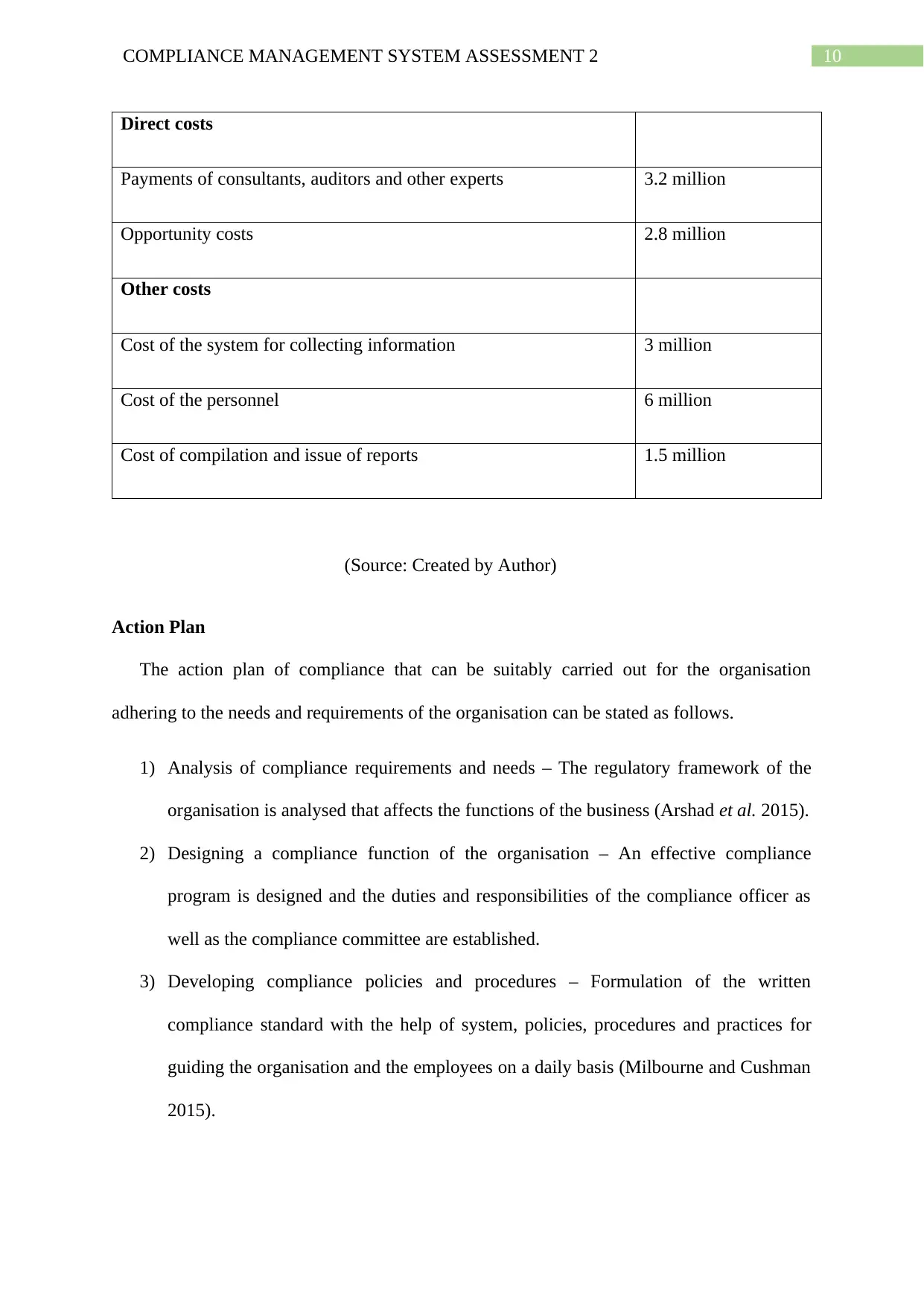
10COMPLIANCE MANAGEMENT SYSTEM ASSESSMENT 2
Direct costs
Payments of consultants, auditors and other experts 3.2 million
Opportunity costs 2.8 million
Other costs
Cost of the system for collecting information 3 million
Cost of the personnel 6 million
Cost of compilation and issue of reports 1.5 million
(Source: Created by Author)
Action Plan
The action plan of compliance that can be suitably carried out for the organisation
adhering to the needs and requirements of the organisation can be stated as follows.
1) Analysis of compliance requirements and needs – The regulatory framework of the
organisation is analysed that affects the functions of the business (Arshad et al. 2015).
2) Designing a compliance function of the organisation – An effective compliance
program is designed and the duties and responsibilities of the compliance officer as
well as the compliance committee are established.
3) Developing compliance policies and procedures – Formulation of the written
compliance standard with the help of system, policies, procedures and practices for
guiding the organisation and the employees on a daily basis (Milbourne and Cushman
2015).
Direct costs
Payments of consultants, auditors and other experts 3.2 million
Opportunity costs 2.8 million
Other costs
Cost of the system for collecting information 3 million
Cost of the personnel 6 million
Cost of compilation and issue of reports 1.5 million
(Source: Created by Author)
Action Plan
The action plan of compliance that can be suitably carried out for the organisation
adhering to the needs and requirements of the organisation can be stated as follows.
1) Analysis of compliance requirements and needs – The regulatory framework of the
organisation is analysed that affects the functions of the business (Arshad et al. 2015).
2) Designing a compliance function of the organisation – An effective compliance
program is designed and the duties and responsibilities of the compliance officer as
well as the compliance committee are established.
3) Developing compliance policies and procedures – Formulation of the written
compliance standard with the help of system, policies, procedures and practices for
guiding the organisation and the employees on a daily basis (Milbourne and Cushman
2015).
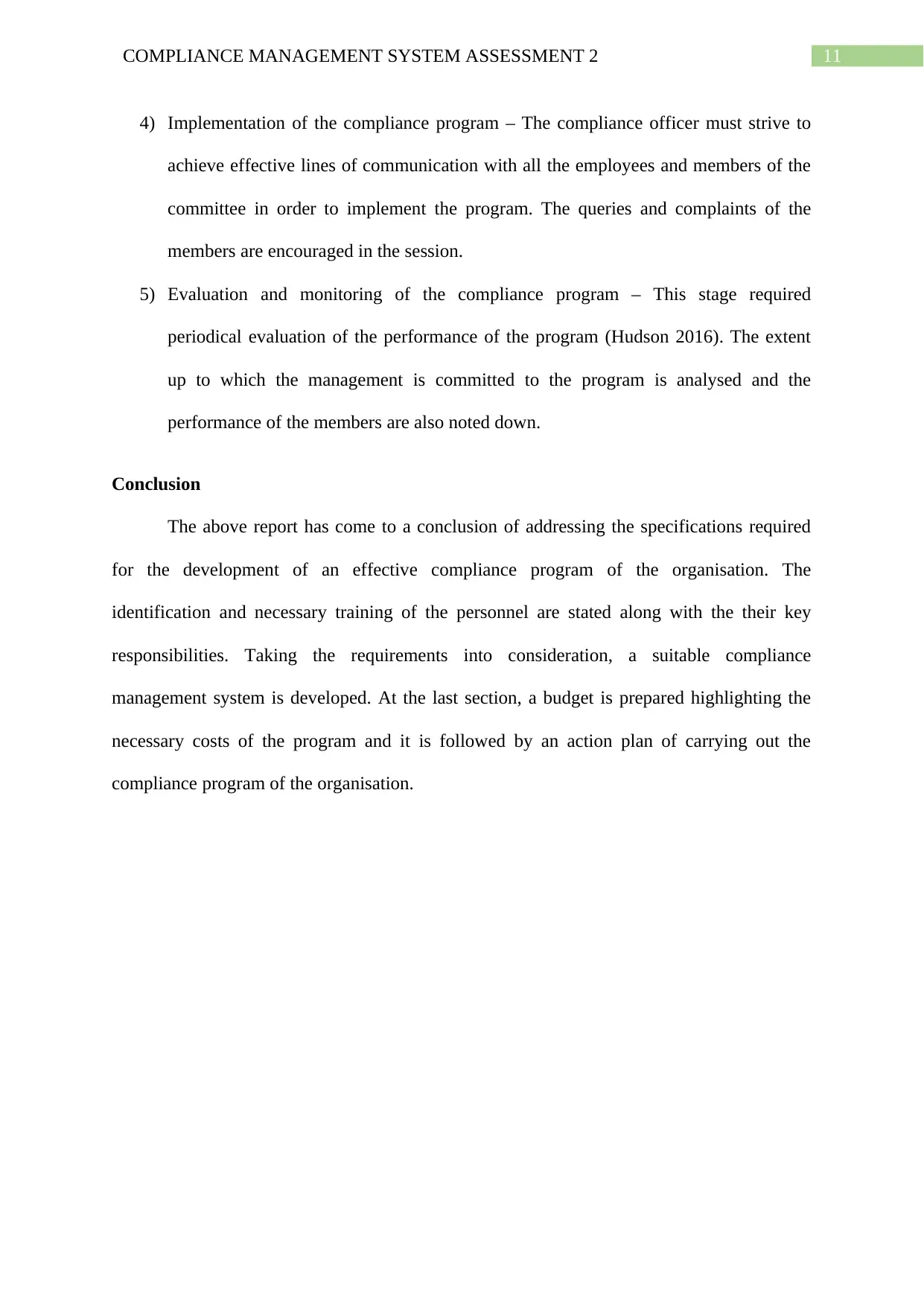
11COMPLIANCE MANAGEMENT SYSTEM ASSESSMENT 2
4) Implementation of the compliance program – The compliance officer must strive to
achieve effective lines of communication with all the employees and members of the
committee in order to implement the program. The queries and complaints of the
members are encouraged in the session.
5) Evaluation and monitoring of the compliance program – This stage required
periodical evaluation of the performance of the program (Hudson 2016). The extent
up to which the management is committed to the program is analysed and the
performance of the members are also noted down.
Conclusion
The above report has come to a conclusion of addressing the specifications required
for the development of an effective compliance program of the organisation. The
identification and necessary training of the personnel are stated along with the their key
responsibilities. Taking the requirements into consideration, a suitable compliance
management system is developed. At the last section, a budget is prepared highlighting the
necessary costs of the program and it is followed by an action plan of carrying out the
compliance program of the organisation.
4) Implementation of the compliance program – The compliance officer must strive to
achieve effective lines of communication with all the employees and members of the
committee in order to implement the program. The queries and complaints of the
members are encouraged in the session.
5) Evaluation and monitoring of the compliance program – This stage required
periodical evaluation of the performance of the program (Hudson 2016). The extent
up to which the management is committed to the program is analysed and the
performance of the members are also noted down.
Conclusion
The above report has come to a conclusion of addressing the specifications required
for the development of an effective compliance program of the organisation. The
identification and necessary training of the personnel are stated along with the their key
responsibilities. Taking the requirements into consideration, a suitable compliance
management system is developed. At the last section, a budget is prepared highlighting the
necessary costs of the program and it is followed by an action plan of carrying out the
compliance program of the organisation.
⊘ This is a preview!⊘
Do you want full access?
Subscribe today to unlock all pages.

Trusted by 1+ million students worldwide
1 out of 14
Related Documents
Your All-in-One AI-Powered Toolkit for Academic Success.
+13062052269
info@desklib.com
Available 24*7 on WhatsApp / Email
![[object Object]](/_next/static/media/star-bottom.7253800d.svg)
Unlock your academic potential
Copyright © 2020–2025 A2Z Services. All Rights Reserved. Developed and managed by ZUCOL.





